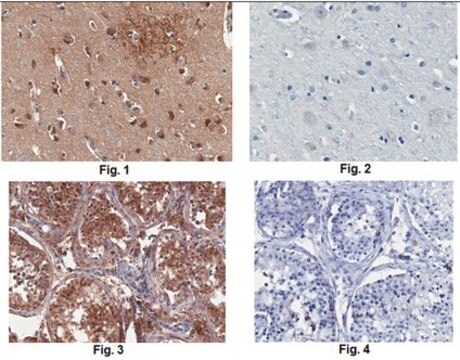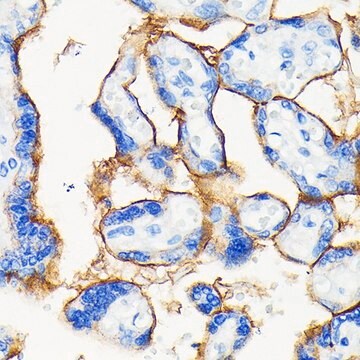IHCR1001-6
Przeciwciało przeciw białku jądrowemu specyficznemu dla neuronów, wstępnie rozcieńczone, klon A60
clone A60, Chemicon®, from mouse
Synonim(y):
NeuN
About This Item
Polecane produkty
pochodzenie biologiczne
mouse
Poziom jakości
forma przeciwciała
purified antibody
rodzaj przeciwciała
primary antibodies
klon
A60, monoclonal
reaktywność gatunkowa
pig, mouse, avian, salamander, rat, primate, human, vertebrates, chicken, ferret
producent / nazwa handlowa
Chemicon®
metody
immunohistochemistry: suitable (paraffin)
Warunki transportu
wet ice
docelowa modyfikacja potranslacyjna
unmodified
informacje o genach
human ... RBFOX3(146713)
Opis ogólny
Specyficzność
Immunogen
Zastosowanie
Obróbka wstępna: Heat Induced Epitope Retrieval (HIER). Zalecany bufor cytrynianowy, pH 6,0 (nr kat. 21545). Bez odzyskiwania epitopu nie wykryto żadnego sygnału.
Inkubacja: 30 minut z IHC Select Detection Kits.
NeuN, został wstępnie rozcieńczony do użycia jako przeciwciało pierwotne z zestawami i protokołami detekcji IHC Select firmy Chemicon (numery katalogowe DAB050, DET-HP1000, APR050 i DET-APR1000), ale można użyć systemów detekcji IHC innych dostawców. Aby uzyskać szczegółowe informacje na temat zoptymalizowanego protokołu, odwiedź stronę www.chemicon.com i wybierz łącze protokoły pod nr kat. Nr kat. IHCR1001-6.
Neuroscience
Neuronal & Glial Markers
Postać fizyczna
Przechowywanie i stabilność
Informacje prawne
Oświadczenie o zrzeczeniu się odpowiedzialności
Nie możesz znaleźć właściwego produktu?
Wypróbuj nasz Narzędzie selektora produktów.
Hasło ostrzegawcze
Warning
Zwroty wskazujące rodzaj zagrożenia
Zwroty wskazujące środki ostrożności
Klasyfikacja zagrożeń
Aquatic Chronic 3 - Skin Sens. 1
Kod klasy składowania
12 - Non Combustible Liquids
Klasa zagrożenia wodnego (WGK)
WGK 2
Temperatura zapłonu (°F)
Not applicable
Temperatura zapłonu (°C)
Not applicable
Certyfikaty analizy (CoA)
Poszukaj Certyfikaty analizy (CoA), wpisując numer partii/serii produktów. Numery serii i partii można znaleźć na etykiecie produktu po słowach „seria” lub „partia”.
Masz już ten produkt?
Dokumenty związane z niedawno zakupionymi produktami zostały zamieszczone w Bibliotece dokumentów.
Nasz zespół naukowców ma doświadczenie we wszystkich obszarach badań, w tym w naukach przyrodniczych, materiałoznawstwie, syntezie chemicznej, chromatografii, analityce i wielu innych dziedzinach.
Skontaktuj się z zespołem ds. pomocy technicznej









